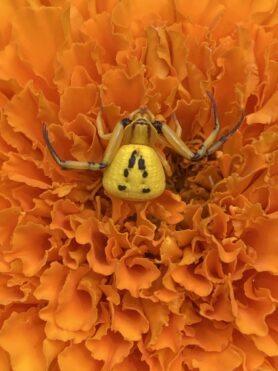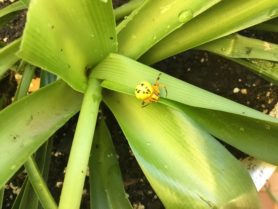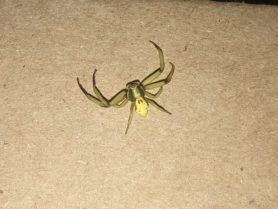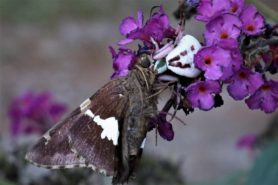Taxonomic Hierarchy
- Kingdom: Animalia
- Phylum: Arthropoda
- Class: Arachnida
- Order: Araneae
- Suborder: Araneomorphae
- Family: Thomisidae
- Genus: Misumenoides
- Species: Misumenoides formosipes
Common Name (AAS )
)
White-banded Crab Spider
Other Common Names
Ridge-faced Flower Spider, Flower Crab Spider, Yellow Crab Spider, White Crab Spider, Crab Spider
Author
Charles Athanase Walckenaer, 1837
Primary Colors
Sightings Overview
There have been 5 confirmed sightings of Misumenoides formosipes (White-banded Crab Spider), with the most recent sighting submitted on August 18, 2023 by Spider ID member mswanstrom. The detailed statistics below may not utilize the complete dataset of 5 sightings because of certain Misumenoides formosipes sightings reporting incomplete data.
- Web: 0% of the time, Misumenoides formosipes spiders are sighted in a spider web (Sample size: 5)
- Sex: 1 female and 0 male.
- Environment: Misumenoides formosipes has been sighted 4 times outdoors, and 1 times indoors.
- Outdoors: On flower (3). Low foliage (1).
Location and Range
Misumenoides formosipes (White-banded Crab Spider) has been sighted in the following countries: United States.
Misumenoides formosipes has also been sighted in the following states: California, Illinois, Tennessee, Wisconsin.
Seasonality
Misumenoides formosipes has been primarily sighted during the month of September.
- January:
- February:
- March:
- April:
- May:
- June:
- July:
- August: 1
- September: 3
- October: 1
- November:
- December:
Additional Remarks
- Species is quite variable in color and pattern.
- In females, the base color of the body is usually yellow, white, or light brown. The abdomen may be with or without red, brown, or black markings and it is widest at the posterior (back) end, appearing as a rounded triangle shape from above. Also somewhat flattened in a side view.
- Adult males are very different than the females. They’re much smaller, only about 1/4 to 1/3 the size of the female, and come in shiny red, yellow, and/or green coloration. Their front legs are dark (usually black) and the rear legs green or yellow.
- A view of the eyes from the front can help distinguish this species from the similar looking “Goldenrod crab spider” (Misumena vatia). In the “Whitebanded crab spider,” there is a conspicuous, white, transverse ridge below the bottom row of eyes called a “clypeal carina.” Misumena vatia does not have such a ridge.
- This species is one of the few spiders in North America that are capable of actively changing their body color from yellow to white, or vice versa, depending on the flower they are perched on. They do this by transferring a liquid, pigmented material to the cuticle. The color change is not instantaneous; it can take anywhere from three to nine days to complete (G. N. Dodson, pers. comm., June 2014).
- Because they usually live on flowers, the majority of their diet includes pollinators (e.g. bumblebees, honeybees, butterflies, moths, syrphid flies, etc). Males often feed on pollen to fuel themselves during their quest for a mate.
- Egg sac is deposited among foliage and is a silken white, lens-shaped “package,” about 10-14mm in diameter, and containing anywhere from 80-180 tan-colored eggs. Female stands guard over it until she dies.
- Related field guide errata: note that in the book “Spiders of the Carolinas” by L.L. Gaddy (2009), there is an image of a male Misumenoides formosipes on page 163 that is labeled incorrectly as a male Misumena vatia. Also in that same book, on the next page, is an image of an immature male Misumena vatia incorrectly labeled as a female Misumenoides formosipes. Additionally, in the book “Spiders of the Eastern United States” by Howell & Jenkins (2004), on page 289, although both images are labeled as Misumena vatia, the top image is actually a female in the genus Mecaphesa (note all the prominent spines on carapace and abdomen) and the bottom image is an adult male Misumenoides formosipes. (If you have this book and are looking at it presently, the adjacent page 288 shows a female species of Xysticus, not a Bassaniana versicolor as it is labeled. There are some additional errors in these books and others, too.)
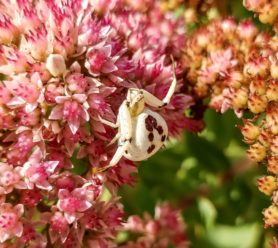 The spider species Misumenoides formosipes, commonly known as White-banded Crab Spider, belongs to the genus Misumenoides, in the family Thomisidae. Misumenoides formosipes spiders have been sighted
The spider species Misumenoides formosipes, commonly known as White-banded Crab Spider, belongs to the genus Misumenoides, in the family Thomisidae. Misumenoides formosipes spiders have been sighted 